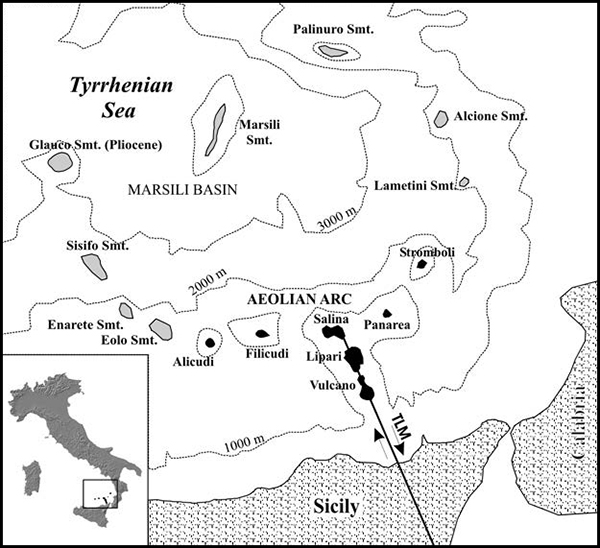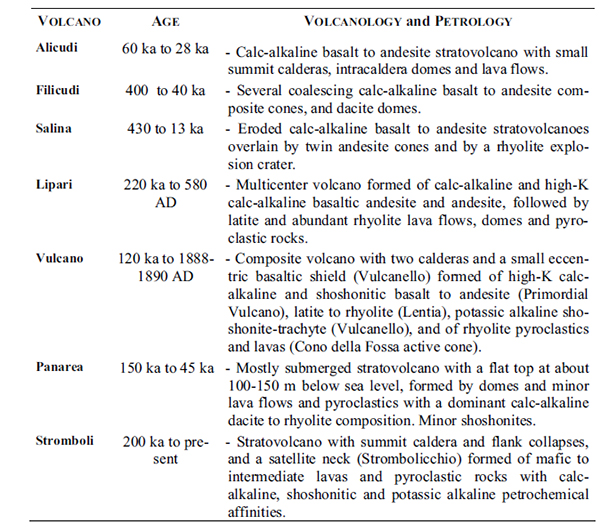The Aeolian archipelago

Location of Aeolian islands and seamounts. TML: Tindari-Letojanni-Malta trectonic line (Peccerillo, 2005).
The Aeolian archipelago is an active volcanic arc in the southern Tyrrhenian Sea. It consists of several stratovolcanoes forming seven main islands and several seamounts, which extend to the west and northeast of the emergent portion of the arc, around the Marsili basin. The volcanic activity exposed above the sea level took place entirely during the Quaternary, most probably from about 400 ka to the present. Rock compositions range from mafic to silicic, and show a calc-alkaline (CA), high-potassium calc-alkaline (HKCA) to shoshonitic (SHO) affinity. A few potassic alkaline rocks with a composition close to the Roman potassic series (KS) occur at Vulcano and Stromboli. Arc tholeiites have been dredged along some seamounts. There are important variations of structural, volcanic and magmatic features along the arc. This makes the Aeolian volcanism an interesting example of a complex subduction-related magmatism, strongly correlated and probably dependent on local features of the lithosphere and related tectonic regime.
The Aeolian Arc has developed over a continental crust along the northern and western margins of the Calabro-Peloritano basement. This is a fragment of the European plate which was affected by complex structural and metamorphic evolution during pre-Hercynian, Hercynian and Alpine orogenies, and migrated away from the Corsica-Sardinia block to its present position during the Miocene to Quaternary opening of the Tyrrhenian Sea.
The Calabro-Peloritano basement runs from northern Calabria to eastern Sicily, and connects the southern Apennine and the Sicily-Maghrebian chains. It is bounded by the Sangineto tectonic line in the north and the Tindari-Letojanni-Malta line in the south. The structure of the Calabro-Peloritano belt consists of a stack of various nappes composed of pre-Alpine metamorphic and granitoid rocks, often with Alpine metamorphic overprint, Mesozoic to Tertiary sedimentary rocks, ophiolitic sequences, and Quaternary sediments. The Aeolian arc consists of three main sectors, each of which shows distinct magmatic, volcanic and structural features:
• The western sector includes the islands of Alicudi, Filicudi and Salina, where the exposed volcanism developed along a W-E trending fault system, between approximately 0.4 Ma and 13 ka. The composition of volcanic rocks is typically calc-alkaline with dominance of mafic and intermediate rocks.
• The central sector includes the islands of Lipari and Vulcano, which developed along the NNW-SSE striking Tindari-Letojanni-Malta line, a dextral strike-slip fault running from the Salina island to the mainland Sicily and to the Malta escarpment. The exposed activity in the central arc has an age younger than about 0.2 Ma, and is characterized by lava flows and pyroclastic rocks that have constructed large stratovolcanoes with calderas. Rock composition is much more variable than in the west, with the presence of mafic to silicic calc-alkaline, shoshonitic and potassic alkaline products. Seismicity is confined to the crust and is concentrated along the Tindari-Letojanni-Malta fault system.
• The eastern sector develops prevailing along NE-SW faults and includes Panarea and Stromboli. The exposed rocks have ages younger than 0.2 Ma. Rock compositions range from mafic to silicic, with calc-alkaline, shoshonitic to potassic alkaline affinity.
Active volcanism is restricted to the central and eastern sectors. At Lipari, the last eruption occurred at about 580 AD, whereas at Vulcano it dates to 1888-1890 AD. At Stromboli, there is continuous mildly explosive strombolian volcanism. Fumaroles and hot springs characterize the submarine zone at Panarea.
The Aeolian magmas are characterised by complex major, trace element and isotopic variations, which are observed both within the single islands and at the regional scale. Petrological, crystal chemistry and fluid inclusion studies on rocks from several islands have shown that magmas have undergone polybaric evolution processes. These were dominated by fractional crystallisation, but crustal assimilation and mixing also played an important role in most centres. Fractional crystallisation was more active in the central islands than in the external volcanoes. In general terms, the Aeolian calc-alkaline rocks have lower degrees of incompatible element enrichment and 87Sr/86Sr ratios at a given silica and MgO content than the associated shoshonitic and potassium alkaline volcanics in the single islands or arc sectors.
The increase of 87Sr/86Sr and the decrease of 143Nd/144Nd from mafic calcalkaline to potassic rocks in the Aeolian arc, along with the increase in incompatible element contents have been suggested to reveal a stronger crustal component in the potassic rocks than in the associated calc-alkaline magmas. Alternatively, different amounts and/or types of upper crustal materials may have been added to the mantle (mantle contamination), whose melting generated a range of geochemically and petrologically different magmas. There is ample evidence that the Aeolian magmas underwent interaction with crustal rocks during their ascent to the surface. Metamorphic xenoliths occur in all the islands, and some appear to have been melted extensively by contact with the enclosing magma. This has lead some authors to propose that crustal assimilation, possibly combined with fractional crystallisation and continuous mixing, might have generated a range of mafic magmas with different levels of enrichment in incompatible elements.
In conclusion, although crustal contamination has been an important evolutionary process at most of the Aeolian volcanoes, it seems inadequate to explain the geochemical and isotopic variations observed from calcalkaline to potassic mafic melts at both local and regional scales. Therefore, many studies concluded that the mafic magmas with different enrichment in potassium reflect primary compositions which were generated in a heterogeneous mantle source.
The coexistence in the Aeolian arc of calc-alkaline, shoshonitic and potassic primary melts showing variable geochemical signatures has been interpreted as an effect of compositional heterogeneities in the mantle wedge and of different degrees of partial melting, decreasing from CA to KS magmas. Isotopic modifications from calc-alkaline to potassic mafic rocks in single islands (e.g. at Vulcano and Stromboli) have brought to suggest vertical compositional heterogeneities within the upper mantle. Alternatively, the mantle source of Aeolian magmas could be permeated by phlogopite-rich veins. Therefore, a variable degree of partial melting of veined peridotite would involve different proportions of veins and host rock, leading to generations of melts with different K2O, incompatible element contents and isotopic signatures.
Whatever model is assumed for the mantle source of Aeolian magmas, Sr-Nd-Pb-He isotope variations call for the involvement of upper crustal components in magma genesis. It can be calculated that less than 10% of upper crust added to a pyrolite mantle could explain the entire range of radiogenic isotopic compositions encountered in the Aeolian mafic rocks. Sediments transported by the Ionian subducting plate represent the most likely candidates for such a mantle source contaminant.
Petrological and geochemical variations along the arc are considered to result from variable relative amounts of slab-released fluids and melts added to the mantle wedge, as well as from higher amounts of subducted sediments added to the mantle beneath eastern islands.
The range of rock compositions occurring within single islands reflects both the variable characteristics of parental magmas and the shallow-level evolution history. In particular, the presence of abundant silicic rocks in the central Aeolian islands has been suggested to depend on extensive fractional crystallisation processes in large magma chambers developed along the horst-graben system associated with the Tindari-Letojanni-Malta strike-slip fault. This fault represents an important structural divide in the Aeolian arc, separating arc sectors characterised by distinct petrological, structural and volcanological settings. Active volcanism and deep seismicity are restricted to central and eastern sectors, whereas they are absent in the west. This has been related to active subduction of the oceanic or thinned continental Ionian plate beneath eastern arc, whose effects are observed until the Campania Province.

Summary of chronology, volcanology and petrology for the Aeolian arc volcanoes. (Peccerillo, 2005).
Bibliography
• Peccerillo. A. Plio-Quaternary Volcanism in Italy. (2005)


